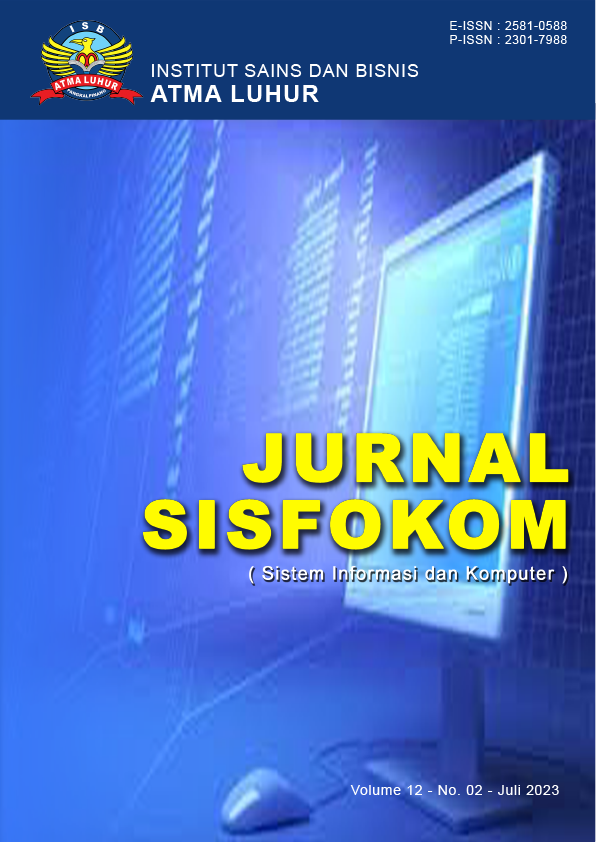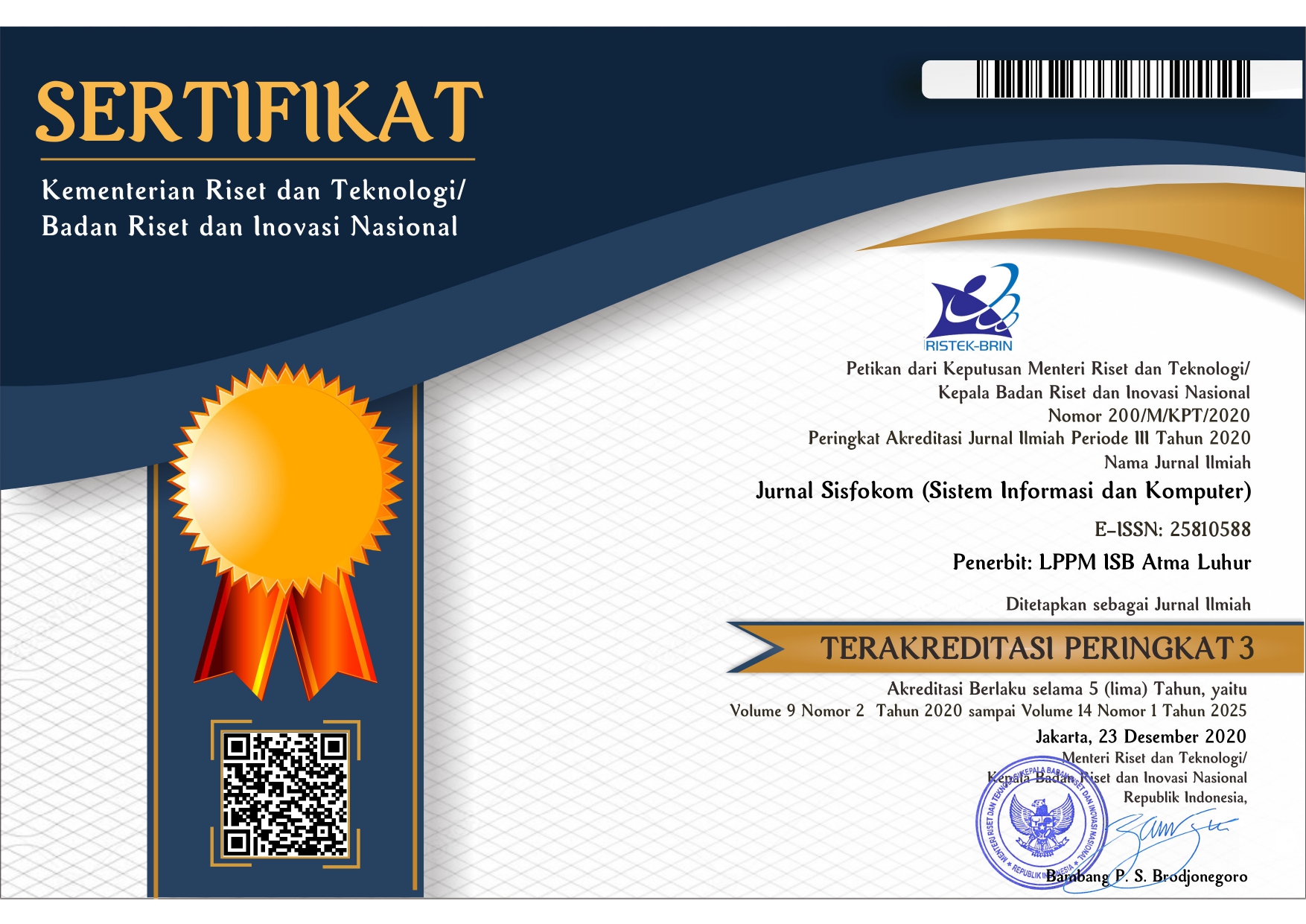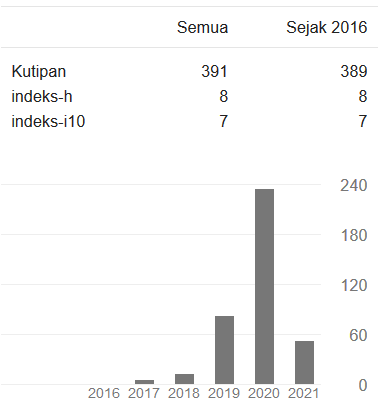Interactive Multimedia Research Trends in Higher Education: A Review of Assisted Literature NVivo 12 Pro
DOI:
https://doi.org/10.32736/sisfokom.v12i2.1648Keywords:
interactive multimedia, utilization, development, higher education, lecturesAbstract
The rapid use of technology in lecture activities, especially the use of interactive multimedia since the pandemic conditions and until now, has attracted researchers to comprehensively analyze patterns of interactive multimedia utilization. This study aims to provide information on the pattern of interactive multimedia utilization and its development to date. The research method adopted a qualitative design, through a review of various studies from 2020 to 2023, and a literature search using the free Publish or Perish program. Further reduction and screening processes were carried out using the PRISMA method. The final results of the articles that have been selected are then mapped and codified with NVivo Pro 12 program, including the development and use of interactive multimedia in universities. In the development of interactive multimedia in the university, literature is grouped into forms of interactive multimedia and tools in designing interactive multimedia. The use of interactive multimedia in institutions is grouped into two, including the types of interactive multimedia used and how the impact of the use of interactive multimedia on lecture activities. Results obtained 1) Multimedia forms developed in universities include E-modules, Software, Websites, Android applications, Autoplay, Classpoint, E-learning, and tutorial models; 2) equipment in designing interactive multimedia including Kwisoft Flopbook Maker, live streaming, Macromedia Flash, Microsoft Way, Moodle, Adobe Flash Professional CS6.5, App Inventor 2, Autocad, Power Point, and Courselab 2.4; 3) types of interactive multimedia used in learning activities in universities include Android applications, Macromedia Flash, Lectora Inspire software, Adobe Flash, Adobe Premiere, and E-learning; 4) The effect of interactive multimedia on lecture activities can increase interest or motivation, also have an impact on student achievement.References
P. Manurung, “Multimedia Interaktif Sebagai Media Pembelajaran Pada Masa Pandemi Covid 19,” Al-Fikru: Jurnal Ilmiah, vol. 14, no. 1, pp. 1–12, 2021, doi: 10.51672/alfikru.v14i1.33.
T. Sugihartono and R. R. C. Putra, “Meningkatkan Minat Belajar Siswa Menggunakan Aplikasi Multimedia Pembelajaran Mobile,” Jurnal Sisfokom (Sistem Informasi dan Komputer), vol. 9, no. 1, pp. 83–88, 2020, doi: 10.32736/sisfokom.v9i1.686.
T. Sugihartono and R. Rian Chrisna Putra, “Analisis Kepuasan Pengguna Menggunakan Technology Acceptance Model pada Sistem Pelayanan Publik,” SATIN - Sains dan Teknologi Informasi, vol. 6, no. 2, pp. 97–105, 2020, doi: 10.33372/stn.v6i2.651.
A. Jayadi and P. A. Firmansani, “Rancang Bangun Animasi Percakapan Bahasa Inggris,” Journal of Software Engineering and Information System (SEIS), vol. 2, no. 1, pp. 120–123, 2022.
R. R. C. Putra, T. Sugihartono, and F. Panca Juniawan, “Aplikasi Augmented Reality Media Pembelajaran Pengenalan Gambar Tokoh Pahlawan Nasional Pada Uang Kertas Berbasis Android,” Jurnal Sisfokom (Sistem Informasi dan Komputer), vol. 10, no. 3, pp. 405–412, 2021, doi: 10.32736/sisfokom.v10i3.1285.
V. Riemer and C. Schrader, “Mental model development in multimedia learning: Interrelated effects of emotions and self-monitoring,” Frontiers in Psychology, vol. 10, no. APR, pp. 1–19, 2019, doi: 10.3389/fpsyg.2019.00899.
Y. Lang, K. Xie, S. Gong, Y. Wang, and Y. Cao, “The Impact of Emotional Feedback and Elaborated Feedback of a Pedagogical Agent on Multimedia Learning,” Frontiers in Psychology, vol. 13, no. June, 2022, doi: 10.3389/fpsyg.2022.810194.
T. W. Liew, W. M. Pang, M. C. Leow, and S. M. Tan, “Anthropomorphizing malware, bots, and servers with human-like images and dialogues: the emotional design effects in a multimedia learning environment,” Smart Learning Environments, vol. 9, no. 1, 2022, doi: 10.1186/s40561-022-00187-w.
Y. Wang, X. Feng, J. Guo, S. Gong, Y. Wu, and J. Wang, “Benefits of Affective Pedagogical Agents in Multimedia Instruction,” Frontiers in Psychology, vol. 12, no. February, pp. 1–14, 2022, doi: 10.3389/fpsyg.2021.797236.
B. Sornson, “Teaching Differently,” Over-Tested and Under-Prepared, no. May, pp. 70–77, 2021, doi: 10.4324/9781315665535-19.
J. S. Thingnes, “Making linguistic choices at a Sámi University: negotiating visions and demands,” Current Issues in Language Planning, vol. 21, no. 2, pp. 153–174, 2020, doi: 10.1080/14664208.2019.1671712.
A. D. Grant, K. Swan, K. Wu, R. Plenty Sweetgrass-She Kills, S. Hill, and A. Kinch, “A Research Publication and Grant Preparation Program for Native American Faculty in STEM: Implementation of the Six R’s Indigenous Framework,” Frontiers in Psychology, vol. 12, 2022, doi: 10.3389/fpsyg.2021.734290.
E. Bozkurt and F. S. Yıldırım, “Determining the Misunderstandings of Physics and Science Teacher Candidates about the Events Related to the Buoyancy Force,” Pegem Egitim ve Ogretim Dergisi, vol. 12, no. 1, pp. 222–231, 2022, doi: 10.47750/pegegog.12.01.23.
M. H. Mahmud, U. M. Baharudin, and Z. Md Isa, “Diseases among Orang Asli community in Malaysia: a systematic review,” BMC Public Health, vol. 22, no. 1, 2022, doi: 10.1186/s12889-022-14449-2.
L. Racine, H. Ford, L. Johnson, and S. Fowler-Kerry, “An integrative review of Indigenous informal caregiving in the context of dementia care,” Journal of Advanced Nursing, vol. 78, no. 4, pp. 895–917, 2022, doi: 10.1111/jan.15102.
S. Mulyanti, J. Mardhiya, and M. Solihah, “Perspectives on Green Chemistry and the Application of Nvivo 12 Software: A Case Study of Pandemic Period in Chemistry Education,” Scientiae Educatia: Jurnal Pendidikan Sains, vol. 11, no. 1, pp. 49–55, 2022.
A. Bandur, “Penelitian Kualitatif (Studi Multi-Disiplin Keilmuan dengan Nvivo 12 Plus),” Jakarta: Mitra Wacana Media, 2019.
I. N. N. Azizah and N. Laily, “Pengembangan multimedia interaktif untuk meningkatkan kemampuan menggali Pengetahuan baru yang terdapat pada teks nonfiksi,” Jurnal Ilmiah Pendidikan Citra Bakti, vol. 10, no. 1, pp. 11–21, 2023, doi: 10.26675/jabe.v2i4.6073.
M. A. Muzakkir, S. W. D. Pomalato, and ..., “Efektivitas Multimedia Interaktif Berbasis Smartphone untuk Pembelajaran Matematika dengan Tatap Muka Terbatas,” Jambura Journal of Mathematics Education, vol. 3, no. 2, pp. 81–92, 2022.
Y. Yurni, S. Edriati, and S. Junaidi, “Pengembangan multimedia pembelajaran interaktif pada mata pelajaran dasar desain grafis,” PeTeKa, 2022, [Online]. Available: http://jurnal.um-tapsel.ac.id/index.php/ptk/article/view/8430.
S. R. Wulan and S. D. Setiarini, “Penerimaan Pembelajar terhadap Penggunaan Scrimba sebagai Multimedia Pembelajaran Interaktif,” Edsence: Jurnal Pendidikan Multimedia, vol. 3, no. 1, pp. 1–8, 2021, doi: 10.17509/edsence.v3i1.32376.
N. Nandi, “Penggunaan Multimedia Interaktif Dalam Pembelajaran Geografi Di Persekolahan,” Jurnal Tata Rias dan Kecantikan, vol. 1, no. 2, pp. 42–48, 2019, doi: 10.17509/gea.v6i2.1741.
A. Denirian R.R and Prihantono, “Pengembangan Multimedia Interaktif Mata Kuliah Ilmu Ukur Tanah I,” Jurnal PenSil, vol. 9, no. 3, pp. 159–164, 2020, doi: 10.21009/jpensil.v9i3.15493.
A. M. Ilmiani, A. Ahmadi, N. F. Rahman, and Y. Rahmah, “Multimedia Interaktif untuk Mengatasi Problematika Pembelajaran Bahasa Arab,” Al-Ta’rib : Jurnal Ilmiah Program Studi Pendidikan Bahasa Arab IAIN Palangka Raya, vol. 8, no. 1, pp. 17–32, 2020, doi: 10.23971/altarib.v8i1.1902.
K. Duwika and M. A. Janardana, “Multimedia Interaktif Model Neurosains dengan Transformasi Mode Daring dan Luring di Era New Normal,” Mimbar Ilmu, vol. 26, no. 3, pp. 506–515, 2021,
T. A. Prayitno and N. Hidayati, “Analisis kebutuhan pengembangan materi biologi umum multimedia interaktif berbasis web dan android,” Prosiding Seminar Nasional IKIP Budi Utomo, vol. 2, no. 1, pp. 263–270, 2021.
F. Khairani, I. W. U. Ningtias, and F. Destini, “Analisis Kebutuhan Multimedia Interaktif Perkuliahan E-Learning pada Mata Kuliah Landasan Kependidikan,” Jurnal Basicedu, vol. 5, no. 6, pp. 5530–5541, 2021, doi: 10.31004/basicedu.v5i6.1582.
V. Kumar and D. Sharma, “E-Learning Theories, Components, and Cloud Computing-Based Learning Platforms,” International Journal of Web-Based Learning and Teaching Technologies Volume, vol. 16, no. 3, pp. 1–16, 2021, [Online]. Available: https://www.igi-global.com/article/e-learning-theories-components-and-cloud-computing-based-learning-platforms/272512.
U. Atiyah, M. Miarsyah, and D. V. Sigit, “The Effect of Using E-Learning Based Guided Discovery Learning Model Based on Self-Efficacy Towards Student Learning Outcomes In Biology Class in Reproductive System Subject in High School,” International Journal for Educational and Vocational Studies, vol. 2, no. 9, pp. 789–796, 2020, doi: 10.29103/ijevs.v2i9.2732.
A. Wijayanto et al., eBook B Strategi Pembelajaran PJKR selama Covid19. 2020.
K. Ayuanita and M. Hafid Effendy, “Model Pembelajaran Menyimak Kritis Melalui Media Interaktif pada Mahasiswa Tadris Bahasa Indonesia IAIN Madura,” GHANCARAN: Jurnal Pendidikan Bahasa dan Sastra Indonesia, vol. 4, no. 1, pp. 62–79, 2022, doi: 10.19105/ghancaran.v4i1.6338.
I. G. A. B. Setya Dewi and N. N. Ganing, “Multimedia Interaktif Berbasis Game Edukasi Dua Dimensi Pada Muatan Bahasa Inggris Materi Pengenalan Kosa Kata,” Jurnal Penelitian dan Pengembangan Pendidikan, vol. 6, no. 1, pp. 81–87, 2022, doi: 10.23887/jppp.v6i1.45896.
Z. Husnawati and N. D. Safitri, “Pengembangan E-Modul Interaktif Sebagai Bahan Ajar Berbasis Tutorial pada Mata Kuliah Multimedia di Masa Pandemi Covid-19,” JUPITER (Jurnal Pendidikan Teknik Elektro), vol. 07, no. 1, pp. 1–9, 2022.[
D. Angga, Cucu Suryana, Ima Nurwahidah, “Peningkatan Aktivitas Belajar Mahasiswa Melalui Media Pembelajaran IPA Berbasis Multimedia Interaktif,” Jurnal basicedu, vol. 6, no. 4, pp. 5877–5889, 2022, [Online]. Available: https://doi.org/10.31004/basicedu.v5i4.1230.
I. K. Yulina, A. Permanasari, H. Hernani, and ..., “Pengembangan Multimedia Interaktif Berbantuan Simulator HPLC untuk Meningkatkan Keterampilan Berpikir Analitis Mahasiswa,” Titian Ilmu: Jurnal Ilmiah Multi Sciences, vol. 14, no. 1, pp. 1–9, 2022,
Downloads
Additional Files
Published
Issue
Section
License
The copyright of the article that accepted for publication shall be assigned to Jurnal Sisfokom (Sistem Informasi dan Komputer) and LPPM ISB Atma Luhur as the publisher of the journal. Copyright includes the right to reproduce and deliver the article in all form and media, including reprints, photographs, microfilms, and any other similar reproductions, as well as translations.
Jurnal Sisfokom (Sistem Informasi dan Komputer), LPPM ISB Atma Luhur, and the Editors make every effort to ensure that no wrong or misleading data, opinions or statements be published in the journal. In any way, the contents of the articles and advertisements published in Jurnal Sisfokom (Sistem Informasi dan Komputer) are the sole and exclusive responsibility of their respective authors.
Jurnal Sisfokom (Sistem Informasi dan Komputer) has full publishing rights to the published articles. Authors are allowed to distribute articles that have been published by sharing the link or DOI of the article. Authors are allowed to use their articles for legal purposes deemed necessary without the written permission of the journal with the initial publication notification from the Jurnal Sisfokom (Sistem Informasi dan Komputer).
The Copyright Transfer Form can be downloaded [Copyright Transfer Form Jurnal Sisfokom (Sistem Informasi dan Komputer).
This agreement is to be signed by at least one of the authors who have obtained the assent of the co-author(s). After submission of this agreement signed by the corresponding author, changes of authorship or in the order of the authors listed will not be accepted. The copyright form should be signed originally, and send it to the Editorial in the form of scanned document to sisfokom@atmaluhur.ac.id.









